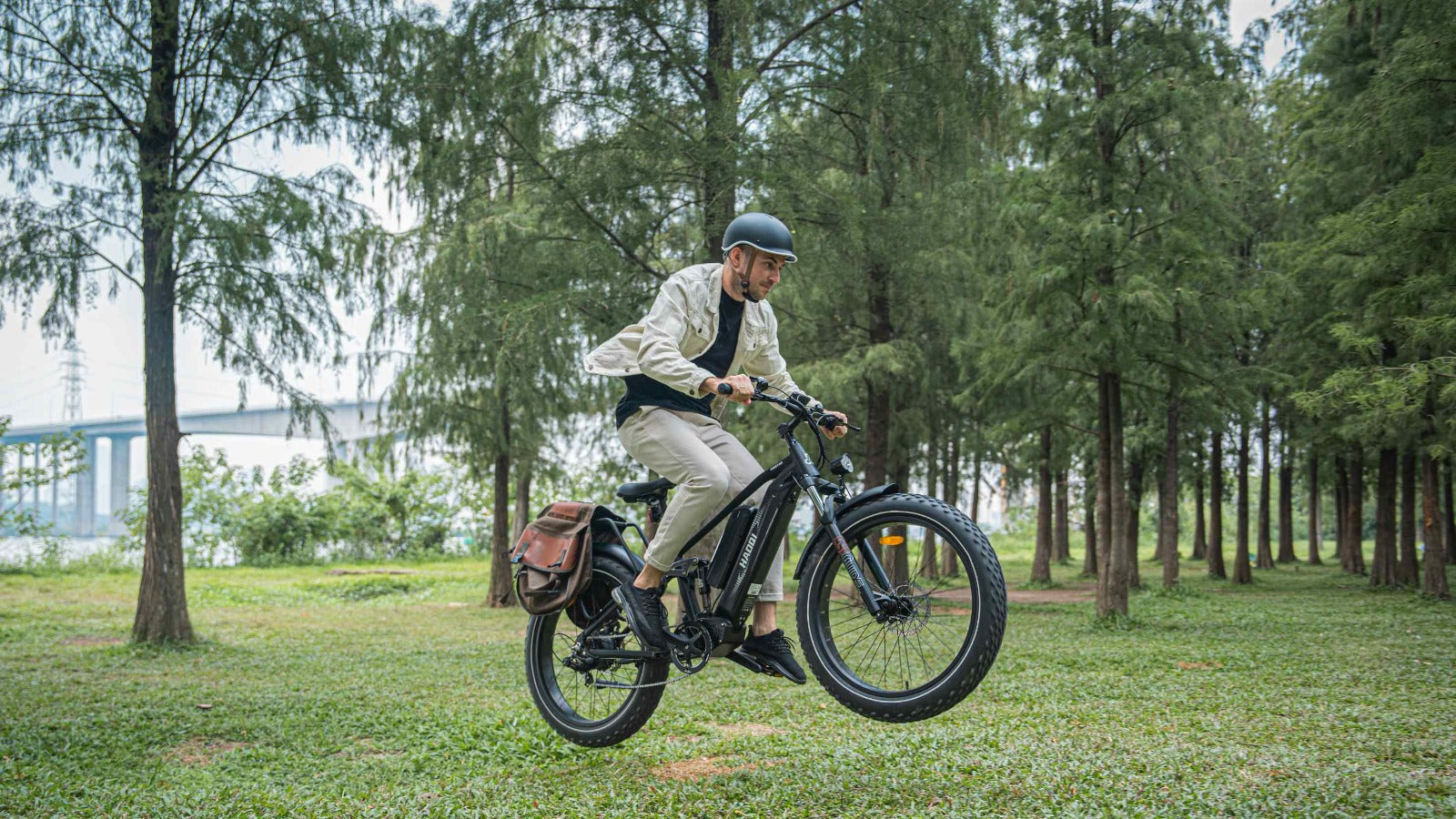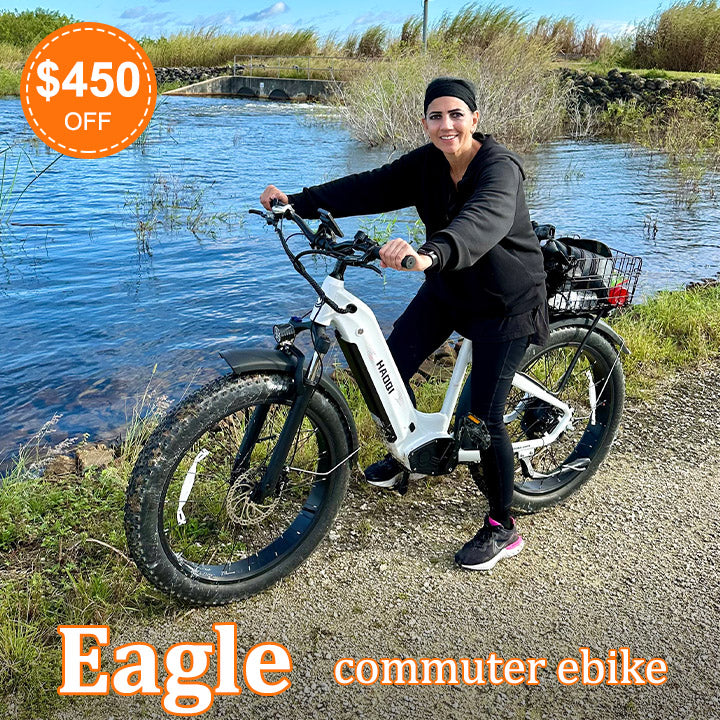Are Electric Bikes Allowed on Bike Trails?
In the ever-evolving landscape of transportation, where the fusion of technology and sustainability reshapes commuting norms, electric bikes (e-bikes) have emerged as a transformative force. Their quiet hums and eco-friendly strides are changing how we navigate our communities, presenting an alternative that transcends conventional modes of transportation. As these two-wheeled marvels gain momentum, a pertinent question surfaces: are electric bikes allowed on traditional bike trails? This article embarks on a comprehensive exploration of this inquiry, peeling back the layers of regulation, classification intricacies, state-specific nuances, and the core tenets of responsible riding. It delves into the heart of a discourse that not only defines the present state of e-bike integration but also propels us forward into an era where the intersection of technology and sustainability reshapes the very contours of our shared mobility spaces.
In our quest for sustainable and efficient transportation, the long-range electric bike represents a significant stride towards a greener future. As cities sprawl and urban spaces grapple with congestion, e-bikes provide a breath of fresh air—literally and metaphorically. The allure of gliding effortlessly through cityscapes or meandering along scenic trails has drawn many towards the silent revolution of electric biking. Yet, with innovation comes the need for regulation and understanding, particularly when it comes to the blending of traditional cycling spaces with their electric counterparts. This exploration seeks not only to unravel the complexities surrounding e-bike permissions on bike trails but also to celebrate the potential harmonious coexistence of old and new, pedal and motor, in the pursuit of sustainable and enjoyable mobility solutions.

Classification of E-bikes
In the diverse realm of electric bikes (e-bikes), their classifications serve as the compass navigating the regulatory landscape. Each classification delineates the nature of assistance provided, speed capabilities, and ultimately, the degree of integration with traditional biking spaces. Understanding these classifications is paramount for unraveling the intricate web of regulations that dictate where and how e-bikes can traverse our shared trails.
Class 1: Pedal-Assist E-bikes
Class 1 e-bikes, often considered the bridge between conventional bicycles and electric counterparts, come equipped with a motor that offers assistance only when the rider pedals. This means that propulsion ceases when the bike reaches a speed of 20 mph. Their seamless integration with the established norms of traditional biking positions Class 1 e-bike as more widely accepted on bike trails. The rider still engages in the physical act of pedaling, blending the motorized assistance seamlessly into the traditional cycling experience.
Class 2: Throttle-Assist E-bikes
In contrast to Class 1, Class 2 e-bikes possess the unique feature of being propelled solely by the motor without requiring pedaling. The motor is engaged with the twist of a throttle, enabling the bike to move forward without the need for continuous pedaling effort. Similar to Class 1 though, the speed assistance is capped at 20 mph, but the autonomy in propulsion adds a layer of distinction. The acceptance of Class 2 e-bikes on bike trails may vary, with some trails embracing their presence and others imposing restrictions based on the divergence from the traditional pedaling experience.
Class 3: Speed Pedelecs
Class 3 e-bikes, colloquially known as speed pedelecs, elevate the speed threshold with the capability to reach up to 28 mph with pedal assistance. This increased speed potential prompts more stringent regulations on certain bike trails. The nuanced consideration revolves around ensuring the safety of both the rider and fellow trail users. The dynamic nature of Class 3 e-bikes opens avenues for faster commuting but also requires a careful examination of the compatibility of such speeds with the trail's existing infrastructure and user dynamics.
Rules, Regulations, and Case Studies of E-bikes on Bike Trails
By States
E-bike regulations exhibit significant divergence from state to state, creating a mosaic of rules that riders must navigate. Some states may categorize e-bikes similarly to traditional bicycles, while others may delineate distinct classifications with specific restrictions. Understanding the rules in your state becomes a foundational step in responsibly integrating e-bikes into the existing trail infrastructure.
California: A Trailblazer in E-bike Legislation
California stands out as a trailblazer in e-bike legislation. In 2015, the state implemented a three-class system, offering a blueprint for categorizing e-bikes based on their capabilities. The evolving nature of California's approach to e-bike regulations underscores the need for a flexible and adaptive framework to accommodate technological advancements.
By E-bike Classifications/Types
The classification of e-bikes serves as a critical determinant of their acceptance on bike trails. A nuanced examination of how each classification is treated provides valuable insights into the diverse regulatory landscape.
Mountain Trails vs. Urban Paths: Tailoring Regulations
Mountain ebike trails may have different regulations than urban commuter bike paths. The topography of trails influences regulatory decisions, creating distinctions between mountain trails and urban paths. Mountain bike trails, characterized by rugged terrains, may necessitate specific restrictions on certain e-bike classes to ensure both rider safety and environmental preservation. Understanding these nuanced distinctions is essential for creating tailored regulations that align with the unique features of each trail type.
Responsibly Using E-bikes While Riding on Bike Trails
While regulations provide a framework, responsible usage is crucial for the harmonious coexistence of e-bikes with traditional cyclists and pedestrians on bike trails.
Adhering to Speed Limits
Respecting designated speed limits for e-bikes on trails is not just a regulatory requirement but a fundamental aspect of responsible riding. Striking a delicate balance between the desire for speed and the safety of fellow trail users contributes significantly to a positive trail experience for everyone.
Yielding to Pedestrians
Pedestrians are an integral part of the trail ecosystem, and e-bike riders must be vigilant in yielding to them. Establishing clear guidelines on yielding and maintaining a safe distance enhances overall safety and ensures a shared trail space where everyone can enjoy their preferred mode of transportation.
Trail Etiquette: Navigating Shared Spaces
Understanding and adhering to trail etiquette is not merely a courtesy; it is an essential aspect of responsible trail use. Signaling intentions, announcing passes, and maintaining a heightened awareness of other trail users all contribute to fostering a positive and inclusive trail environment.
Conclusion
In the dynamic interplay of wheels and wires, the question of whether electric bikes (e-bikes) are permitted on traditional bike trails unfolds into a tapestry of regulation, classification intricacies, and the ethos of responsible riding. As the whirr of e-bike motors harmonizes with the rhythmic hum of traditional pedal-powered cycles, it becomes evident that the future of shared mobility spaces is evolving. This exploration, traversing the corridors of e-bike legislation, state-specific variations, and the responsible conduct expected from riders, not only defines the present state of integration but also sketches the contours of a future where innovation and sustainability coexist seamlessly.
E-bikes, with their silent revolutions and eco-friendly strides, embody a shift towards a greener, more efficient transportation era. As we navigate urban jungles and embrace the allure of scenic trails, the integration of e-bikes beckons us to reassess the boundaries of shared spaces. The exploration undertaken here is not just a scrutiny of rules but a celebration of the potential harmonious coexistence of old and new, pedal and motor. It is a testament to the ongoing dialogue between innovation and regulation, where the wheels of progress turn towards a future where sustainable and enjoyable mobility solutions carve their place in the diverse landscape of bike trails. As we pedal into this future, the blend of tradition and technology becomes not just a regulatory challenge but an opportunity to redefine the way we move, commune, and experience the world on two wheels.
![50L Ebike Pannier Commuting Bag [electric bike] [HAOQI ebike]](http://haoqiebike.com/cdn/shop/files/20231119-190333.jpg?v=1700449457&width=1500)
![Waterproof and Dustproof Outdoor Ebike Cover [electric bike] [HAOQI ebike]](http://haoqiebike.com/cdn/shop/files/23.6.1-_1.jpg?v=1685601686&width=1500)
![HAOQI E-bike Foldable Hitch Rack [electric bike] [HAOQI ebike]](http://haoqiebike.com/cdn/shop/products/1_a930939f-7dd1-4cc5-b498-37e730bdb42d.jpg?v=1674896982&width=1500)
![Aerodynamic Brim Ebike Helmet with Rear Light [electric bike] [HAOQI ebike]](http://haoqiebike.com/cdn/shop/files/1500x1000-1_4815412b-fea5-4687-91ce-ce806d3c0e7a.jpg?v=1684394955&width=1500)
![HAOQI Ebike Pet Trailer [electric bike] [HAOQI ebike]](http://haoqiebike.com/cdn/shop/products/1_07ccf951-8d3e-4759-a684-e7e99e88924a.jpg?v=1681962880&width=1500)
![17mm Durable Anti-theft Ebike U-Lock [electric bike] [HAOQI ebike]](http://haoqiebike.com/cdn/shop/files/1500x1000.jpg?v=1684381885&width=1500)
![Ebike Sunglasses with 5 Interchangeable Lenses [electric bike] [HAOQI ebike]](http://haoqiebike.com/cdn/shop/files/23.6.1-_2.jpg?v=1685688612&width=1500)
![Magnetic Snap-On Ebike Helmet with Windproof Visor [electric bike] [HAOQI ebike]](http://haoqiebike.com/cdn/shop/files/20230518-134119.jpg?v=1684389276&width=1500)
![360° Adjustable Durable Phone Mount [electric bike] [HAOQI ebike]](http://haoqiebike.com/cdn/shop/files/23.6.28-_-2.jpg?v=1688009135&width=1500)
![Child Ebike Trailer [electric bike] [HAOQI ebike]](http://haoqiebike.com/cdn/shop/files/20230927-115835.jpg?v=1695787158&width=1500)
![Waterproof e-bike Frame Bag [electric bike] [HAOQI ebike]](http://haoqiebike.com/cdn/shop/products/waterproof-e-bike-frame-bag-haoqiebike-com-1.jpg?v=1671781181&width=1500)










![HAOQI Squirrel Folding Electric Bike [electric bike] [HAOQI ebike]](http://haoqiebike.com/cdn/shop/files/1_76cd6814-2583-4aff-9e8e-ee7699023aa3.jpg?v=1708422636&width=1500)
![HAOQI Black Leopard Pro Fat Tire Electric Bike [electric bike] [HAOQI ebike]](http://haoqiebike.com/cdn/shop/products/20230325-152500.jpg?v=1687856895&width=1500)
![HAOQI Upgraded Eagle Long Range Electric Bicycle [electric bike] [HAOQI ebike]](http://haoqiebike.com/cdn/shop/files/2_d6c832f0-a92d-4af4-91ff-5389e22240e5.jpg?v=1710230237&width=1500)
![HAOQI Rhino Electric Motorbike [electric bike] [HAOQI ebike]](http://haoqiebike.com/cdn/shop/files/2_14eede67-f744-42a8-b8c8-6ea22b59f26b.jpg?v=1691720331&width=1500)
![HAOQI Antelope Pro 750W Cargo Electric Bike [electric bike] [HAOQI ebike]](http://haoqiebike.com/cdn/shop/products/haoqi-antelope-pro-cargo-electric-bike-with-dual-battery-750w-haoqiebike-com-1.jpg?v=1687856878&width=1500)
![HAOQI Camel Electric Cargo Bike - Latest SUV Ebike [electric bike] [HAOQI ebike]](http://haoqiebike.com/cdn/shop/files/1_8a55ca84-c76a-4bc0-9fb5-7a3010f3778d.jpg?v=1708422550&width=1500)
![HAOQI Cheetah Full Suspension Electric Bike - Flagship Ebike [electric bike] [HAOQI ebike]](http://haoqiebike.com/cdn/shop/files/6_60022b3b-c503-4719-81c7-3ef95f63402e.jpg?v=1709866825&width=1500)
![HAOQI Cheetah Pro Mid-Drive Full Suspension Ebike [electric bike] [HAOQI ebike]](http://haoqiebike.com/cdn/shop/files/23.11.6-1500X1000_1.jpg?v=1699319690&width=1500)
![HAOQI Cheetah Full Suspension Electric Bike - Flagship Ebike [electric bike] [HAOQI ebike]](http://haoqiebike.com/cdn/shop/files/38_bd17be38-4444-48af-8a0e-a8ab6b7d0585.jpg?v=1692178338&width=1500)
![HAOQI Eagle Long Range Electric Bicycle [electric bike] [HAOQI ebike]](http://haoqiebike.com/cdn/shop/files/1_67dad26d-6f48-4641-9f0d-67ca931aac28.jpg?v=1710229843&width=1500)
![HAOQI Antelope 500W Cargo Electric Bike [electric bike] [HAOQI ebike]](http://haoqiebike.com/cdn/shop/products/haoqi-antelope-cargo-electric-bike-with-dual-battery-haoqiebike-com-1.jpg?v=1687857274&width=1500)
![HAOQI Silver Antelope Pro 750W Cargo Electric Bike [electric bike] [HAOQI ebike]](http://haoqiebike.com/cdn/shop/products/haoqi-antelope-pro-cargo-electric-bike-with-dual-battery-750w-haoqiebike-com-5_b186ce8f-5695-4f3c-85ef-adaa976b6cc5.jpg?v=1687856908&width=1500)
![HAOQI White Leopard Pro Step Thru Electric Bike [electric bike] [HAOQI ebike]](http://haoqiebike.com/cdn/shop/products/haoqi-white-leopard-step-thru-electric-bike-haoqiebike-com-1.jpg?v=1687856892&width=1500)
![HAOQI Green Leopard Pro Fat Tire Electric Bike [electric bike] [HAOQI ebike]](http://haoqiebike.com/cdn/shop/products/haoqi-green-leopard-pro-fat-tire-electric-bike-haoqiebike-com-1.jpg?v=1687856904&width=1500)
![HAOQI MINI Foldable Electric Bike [electric bike] [HAOQI ebike]](http://haoqiebike.com/cdn/shop/products/haoqi-r-mini-foldable-electric-bike-haoqiebike-com-1.jpg?v=1671781415&width=1500)
![HAOQI TerraGlide 26''x4'' Durable Mountain Bike Tire [electric bike] [HAOQI ebike]](http://haoqiebike.com/cdn/shop/files/02_1500x1000_a9bdef41-bae2-4633-80f2-99a827eac05c.jpg?v=1700206486&width=1500)
![Kids Bike Seat Pack for Camel Cargo Ebike [electric bike] [HAOQI ebike]](http://haoqiebike.com/cdn/shop/files/23.11.22-1500x1000-_4.jpg?v=1700637028&width=1500)
![HAOQI Ebike 35L Waterproof Ebike Saddle Bag [electric bike] [HAOQI ebike]](http://haoqiebike.com/cdn/shop/files/20231221-232114.jpg?v=1703229828&width=1500)
![HAOQI Winter Warm Touchscreen Waterproof Cycling Gloves [electric bike] [HAOQI ebike]](http://haoqiebike.com/cdn/shop/files/23.11.22-1500x1000-_2_0ef50e92-a96c-4616-8779-b34f80fd1676.jpg?v=1700637117&width=1500)
![Rear Frame Basket [electric bike] [HAOQI ebike]](http://haoqiebike.com/cdn/shop/files/20230701-115551.jpg?v=1688190192&width=1500)
![Front Frame Basket [electric bike] [HAOQI ebike]](http://haoqiebike.com/cdn/shop/files/20230701-115623.jpg?v=1688191566&width=1500)
![HAOQI Ebike Aluminum Bike Cup Holder [electric bike] [HAOQI ebike]](http://haoqiebike.com/cdn/shop/files/001.jpg?v=1700115151&width=1500)
![HAOQI Oversized Soft Bike Saddle [electric bike] [HAOQI ebike]](http://haoqiebike.com/cdn/shop/files/20231224-194643.jpg?v=1703476081&width=1500)




Leave a comment